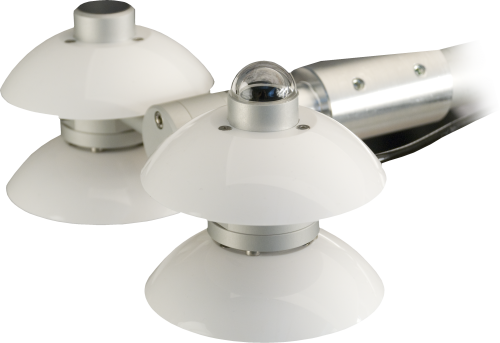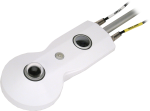
强健的4分量净辐射表,只需要很小的维护






概览
NR01 是一种科研级的净辐射表,测量入射短波辐射和长波红外辐射,相对于地表反射的短波辐射和向上长波红外辐射的能量平衡。我们的数据采集器可以测量NR01的输出信号和控制它的内部加热器。这种净辐射表为科研级的能量平衡研究提供了专业的解决方案。
优势与特点
- Internal RTD provides temperature compensation of measurements
- Research-grade performance
- Internal 1-W heater reduces formation of dew and melts frost
- Separate outputs of short-wave and long-wave infrared radiation for better accuracy and more thorough quality assurance
- Robust—only requiring limited maintenance
图像

技术说明
NR01 包含成对的短波辐射表和长波辐射表,一组短波辐射表和长波辐射表朝上,另一组朝下。短波辐射表测量短波辐射,长波辐射表测量远红外辐射。
NR01 包含内置的RTD传感器用来测量辐射表的内部温度,以及1-W的加热器用来最小化露的生成和熔化霜。为了减少功率消耗,通常延时启动加热器,仅当太阳辐射小于 20 W/m2时才启动。
坎贝尔的CR3000 和 CR5000 数据采集器适合测量这种净辐射表。也可采用CR1000 数据采集器,不过需要4WPB100 模块来测量净辐射表的内部温度。
产品规格
| Sensor | Hukseflux’s SR01 ISO-class, thermopile pyranometers, IR01 pyrgeometers, PT100 RTD |
| Measurement Description | Measures incoming and outgoing short-wave and long-wave radiation |
| Response Time | 18 s |
| Sensitivity | 10 to 40 μV W-1 m2 |
| Expected Output Range | -0.1 to +50 mV |
| Expected Accuracy for Daily Totals | ±10% |
| Heater | 90 ohm, 1.6 W (at 12 Vdc) |
| Operating Temperature Range | -40° to +80°C |
| Heater Current Drain | ~140 mA |
| Dimensions | 26.3 x 11.3 x 12.1 cm (10.4 x 4.4 x 4.8 in.) |
| Weight |
|
Pyranometer |
|
| Spectral Range | 305 to 2800 nm |
Pyrgeometer |
|
| Spectral Range | 4500 to 50,000 nm |
兼容性
Please note: The following shows notable compatibility information. It is not a comprehensive list of all compatible products.
数据采集器
| Product | Compatible | Note |
|---|---|---|
| CR1000X (retired) | A 4WPB100 PRT Bridge Module is required to measure the internal RTD. | |
| CR3000 (retired) | ||
| CR6 | ||
| CR800 (retired) | ||
| CR850 (retired) |
固定设备
| Product | Compatible | Note |
|---|---|---|
| 26120 |
Additional Compatibility Information
Mounting
To avoid shading or reflections and to promote spatial averaging, the NR01 should be mounted at least 1.5 m above the ground or crop canopy and away from all obstructions or reflective surfaces that might adversely affect the measurement. Campbell Scientific recommends mounting the NR01 to a CM300-series mounting pole at least 25 feet away from other mounting structures. The NR01 is attached to the CM300-series mounting pole via a CM204 or CM206 crossarm.
相关技术文档
产品样册
说明书
常见问题解答
NR01-T1: 9
展开全部收起全部
-
As a general guide, go at least 1.5 m above the tallest plant (tree) in an ecosystem.
-
Shading and reflection are important aspects to consider. The sensor should have a clear view of the upward hemisphere of the sky. To avoid shading effects and to promote spatial averaging, the sensor should be mounted at least 1.5 m above the ground surface.
-
Only one 4WPB100 is needed to measure the internal PRT in the radiometer.
-
As of June 2013, all of our current and retired net radiation sensors can be mounted using this kit. These include:
- Current sensors: CNR4-L, NR-LITE2-L, and NR01-L
- Retired sensors: CNR1, CNR1-L, CNR2-L, NR-LITE-L, and Q7.1-L
-
Mount the net radiometer so that no shadow will be cast on it at any time of day from obstructions such as trees, buildings, the mast, or the structure on which it is mounted.
Campbell Scientific recommends installing a net radiometer in an open area, away from the main weather station structure on a separate vertical mast. If it is necessary to install this sensor on the main tall tower (30 ft or taller), the sensor should be installed at the top of the tower. In the northern hemisphere, the sensor should be facing south. In the southern hemisphere, the sensor should be facing north. If the tower uses a solar power system (that is, solar panels), ensure that the solar panels are installed away from the main tower.
-
It is possible that an older version of Short Cut is being used. Download the latest version of Short Cut.
For programming assistance, consult the NR01-L instruction manual. For additional assistance, contact Campbell Scientific.
-
Campbell Scientific recommends that the sensor be mounted to a separate vertical pipe at least 25 ft from any other mounting structures.
-
Because of the loss of IR radiation, nearly all thermopile instruments typically have a negative offset. This offset is most easily visible at night-time, when a small negative value is read instead of zero. This same offset is present during the daytime, but it is not as visible because of the large solar signal.
Another common issue involves leveling an instrument. Leveling a thermopile instrument can cause errors in the direct beam component because the cosine response is not correct. These errors are more notable when the sun is close to the horizon because the angle is so shallow.
案例研究
Tropical volcanic islands are biodiversity hotspots where the Critical Zone (CZ) remains poorly studied. In......阅读更多
The Utah Geological Survey, supported by the Utah Division of Water Rights, has constructed a......阅读更多




